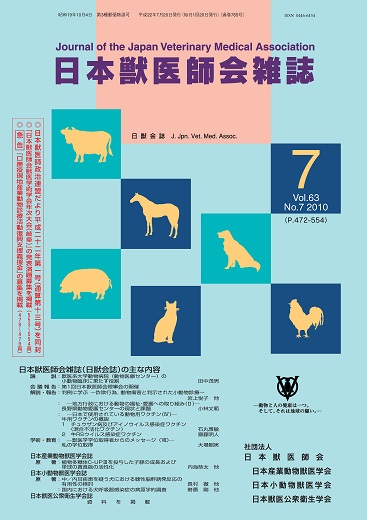All issues

Volume 63, Issue 7
Displaying 1-7 of 7 articles from this issue
- |<
- <
- 1
- >
- >|
The Japanese Society of Farm Animal Veterinary Medicine
-
Kyota UTSUMI, Nobuo NAKANISHI, Koji YAMADA, Satoshi YOSHIDAArticle type: Original Article
2010Volume 63Issue 7 Pages 519-523
Published: July 20, 2010
Released on J-STAGE: September 07, 2016
JOURNAL FREE ACCESSWe examined the latex bead phagocytic activity (number of phagocytes or phagocytic rate) of monocytes and the growth of piglets, given the plant polysaccharide supplement C-UPⅢ. Feed mixed with 0% (control), 0.05%,0.1%, 0.2% or 0.4% of C-UPⅢ was given on three consecutive days to recently weaned piglets. Increased phagocytic activity of monocytes was noted in all C-UPⅢ-treated groups at 7 and 14 days following the start of treatment. Meanwhile lower phagocytic activity was noted in the control groups, compared to before the treatment. The weight gain and feed conversion rate were higher in all C-UPⅢ groups than in the control piglets, especially in the 0.2% and 0.4% C-UPⅢ groups. These results suggest that C-UPⅢ is an effective way of promoting immunological activation in recently weaned piglets with lowered biophylaxis.View full abstractDownload PDF (329K) -
Masanao MATAYOSHI, Hisashi FUNAKURA, Kenta URAE, Kenji YOKOGAWA, Toru ...Article type: Short Communication
2010Volume 63Issue 7 Pages 524-526
Published: July 20, 2010
Released on J-STAGE: September 07, 2016
JOURNAL FREE ACCESSAn eight-year-old breeding Japanese Black cattle showing swollen and palpable induration in the right front quarter was diagnosed with clinical mastitis using the California Mastitis Test, on Ishigaki Island, Okinawa Prefecture, Japan, on June 2009. Pastuerella multocida was isolated from the milk sample of the cattle purely with a titer of 623 CFU/ml. The isolate was determined as serotype A : 3, 4 by capsular PCR typing and gel diffusion precipitation. ToxA gene encoding Pasteurella multocida toxin was not detected from the isolate. This is the first case report of Japanese black cattle mastitis associated with P. multocida in Japan.View full abstractDownload PDF (277K) -
Nobuhiko TANIMURA, [in Japanese], [in Japanese], [in Japanese], [in Ja ...Article type: Data and Information
2010Volume 63Issue 7 Pages 527-530
Published: July 20, 2010
Released on J-STAGE: September 07, 2016
JOURNAL FREE ACCESSDownload PDF (707K)
The Japanese Society of Small Animal Veterinary Medicine
-
Toru OSAMURA, Miyoko SAITO and, Kazuhiko NAMIKAWA , Hideharu OCHIAIArticle type: Original Article
2010Volume 63Issue 7 Pages 531-537
Published: July 20, 2010
Released on J-STAGE: September 07, 2016
JOURNAL FREE ACCESSAbnormal brainstem auditory-evoked responses (BAER) were recorded in five dogs with suspected middle/inner ear diseases. BAER abnormalities were consistent with conductive, cochlear sensorineural, or retrocochlear sensorineural hearing impairment, and these results enabled us to reveal otitis media, interna, or brainstem disease, respectively. Since BAER can be obtained from a dog with no or only mild sedation, this test was useful, especially in a situation where general anesthesia is undesirable or repeated examinations are needed. Our results indicated that BAER is of great value in helping to arrive at a diagnosis or in conducting a follow-up evaluation of middle/inner ear diseases in dogs where the lesion localization was in the auditory pathway.View full abstractDownload PDF (425K) -
Go SEHATA, Akira WAKATSUKI,, Katsuo MASUBUCHI, Takuo TAKAHASHI , Ter ...Article type: Original Article
2010Volume 63Issue 7 Pages 538-542
Published: July 20, 2010
Released on J-STAGE: September 07, 2016
JOURNAL FREE ACCESSThe oral, nasal, and ocular swabs collected from 119 dogs suffering from canine infectious respiratory disease (CIRD) were tested for canine adenovirus type 2 (CAV-2), canine parainfluenza virus (CPIV), canine distemper virus (CDV), canine herpes virus (CHV), canine respiratory coronavirus (CRCoV) and Bordetella bronchiseptica (Bb) genes using a polymerase chain reaction method. The most prominent pathogen detected in 47 dogs positive for a single pathogen was Bb, followed by CRCoV, CPIV, CDV, CAV-2 and CHV in 15, 13, 9,6, 2 and 2 dogs, respectively. Similarly, Bb, CPIV and CRCoV were more common in 16 dogs of mixed infection, and were detected in 13, 9 and 6 dogs, respectively. These results appear to suggest that Bb, CPIV and CRCoV are major pathogens for CIRD, and concomitant infection with Bb and other pathogens exacerbates the disease. In addition, CPIV, CAVh2 and CDV were apt to be detected less frequently in dogs administered pre viously with the multivalent live vaccine including those viruses, compared to those unvaccinated, indicating that the vaccination was effective for preventing infections in dogs.View full abstractDownload PDF (238K) -
Yasunori MORITA, Yoshiko MORITAArticle type: Short Communication
2010Volume 63Issue 7 Pages 543-547
Published: July 20, 2010
Released on J-STAGE: September 07, 2016
JOURNAL FREE ACCESSThe plasma concentrations of two acute phase proteins, α1-acid glycoprotein (α1-AG) and C-reactive protein (CRP), were measured in nine dogs with immune-mediated hemolytic anemia (IMHA), to evaluate its usefulness in determining the prognosis. In six dogs achieving complete remissions through immunosuppressive treatments, α1-AG and CRP concentrations decreased into the normal range quickly. Of the three dogs that died despite treatment, CRP concentrations showed no clear pattern. On the other hand, α1-AG concentrations remained high in all dogs with poor prognosis. These findings suggest that the change in plasma α1-AG concentration after treatments could be a useful marker for evaluating the prognosis in dogs with IMHA, whereas the change in the plasma concentration of CRP does not predict the prognosis in certain dogs with IMHA.View full abstractDownload PDF (282K)
The Japanese Society of Veterinary Public Health
-
Toshio NOBUSAWA, Akihiro WATARIArticle type: Data and Information
2010Volume 63Issue 7 Pages 549-552
Published: July 20, 2010
Released on J-STAGE: September 07, 2016
JOURNAL FREE ACCESSDownload PDF (432K)
- |<
- <
- 1
- >
- >|